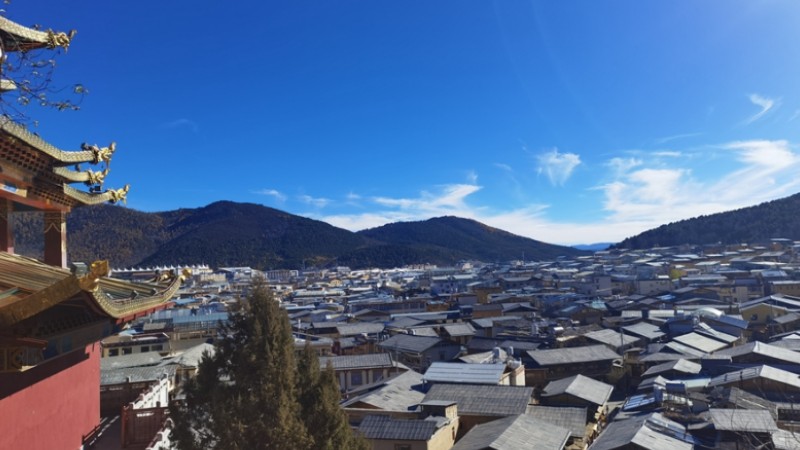Water diversion project brings many benefits

Water is drawn for the eastern route of the South-to-North Water Diversion project from the lower reaches of the Yangtze River at Jiangdu in Yangzhou city, Jiangsu province. YU XING/FOR CHINA DAILY
Relief provided for eastern areas long plagued by drought
The sun shone brightly as my father carried water from a small pond in a metal bucket, scrambling to fill a makeshift tank on our tractor bed.
After days of scorching temperatures, the pond was one of the few water bodies in our village that still had supplies, but the water level was low. This meant my father had to walk a long way on a slippery slope to reach the water.
As it was so hot, he removed his shirt, and sweat streamed down his face. His shoulders and part of his back were sunburned.
At that time in the mid-1990s, I was just a young boy, and although I was there to help, I cannot recall exactly what I did.
This childhood memory suddenly returned to me this month as I stood in a control center for the eastern route of the South-to-North Water Diversion Project.
Mo Zhaoxiang, head of the information center at Jiangsu Water Source Co in Nanjing, capital of Jiangsu province, said that with a simple click of a computer mouse, water pumps up to 400 kilometers away will start operating in just five seconds.
Pumping stations in Jiangsu along the route can deliver 100 cubic meters of water per second all the way to the north.
I was on an interview tour ahead of the 10th anniversary of the eastern route starting operation on Nov 15, 2013.
Water is drawn for this route from the lower reaches of the Yangtze River at Jiangdu in Yangzhou city, Jiangsu. The ancient Beijing-Hangzhou Grand Canal and its parallel rivers are used to divert water to northern China through a series of pumping stations.

The project's operation room in Huai'an, Jiangsu. YIN CHAO/FOR CHINA DAILY
One of the destinations water is diverted to is my hometown of Weihai in the most easterly part of Shandong province.
Facing the sea in all directions but the west, Weihai was once plagued by a water shortage.
The makeshift tank on our tractor bed, which was made from thin plastic, could only hold about 5 cu m of water. After filling it up, my father drove the tractor to our farmland about 2 kilometers away to water corn seedlings, which were severely parched due to persistent drought.
There was no cover for the tank, so after bumping along a rugged country road for about 10 minutes, we had lost at least 0.5 cu m of water.
Each of the corn seedlings on our 0.13 hectares of farmland could only be given water from two large ladles made from gourds.
My father and I were not alone in fetching water from the small pond, and it was quite a chaotic scene. There were so many tractors that it took at least five minutes to escape the traffic jams, although the size of the pond could be compared to that of a basketball court.
Such scenes were familiar to residents in Weihai, who had been fighting drought for generations.
Key points
On a big screen at the water diversion project's control center, a large electronic map shows key points on the eastern route. One end of the route is the Mishan Reservoir in Weihai, which I am familiar with, as my grandfather-in-law helped build it.

The project's operation room in Huai'an, Jiangsu. YIN CHAO/FOR CHINA DAILY
A participant in the Huaihai Campaign, one of the three major battles in the War of Liberation (1946-49), he never shared his wartime experiences with me. However, he told me some of his memories of building the reservoir, one of whose major functions was to store water to help with drought relief.
He was one of more than 10 young laborers designated by his village committee to help build the reservoir. The laborers lived on the construction site for three months in tents. Despite having no wages, they had to carry all their food and other necessities, and also cook for themselves.
With no support from machinery, they worked simply, carrying shoulder poles and large baskets. After continuous efforts from numerous groups of young laborers from different villages, the reservoir was completed in 1960, although I don't know how long the construction took.
As the largest reservoir in Weihai, it can hold 280 million cu m of water.
In 2005, I left Weihai for university, and since then I have seldom stayed in the city for more than a week, but I still hear frequent accounts of how drought wreaked havoc in my hometown.
My mother once phoned me to say the water supply to the middle school in our village had been disrupted because of drought, and students boarding at the school had no water to wash their clothes or take a shower. They discarded numerous towels, as they had been used for a long time without being washed.
Such scenes may never happen again in many areas of Shandong, thanks to the giant water diversion project.
When Weihai and the nearby cities of Qingdao, Yantai and Weifang experienced a prolonged drought from 2014 to 2018, the project delivered water to the four cities for 893 consecutive days. The China Eastern Route Corp of South-to-North Water Diversion said it transported more than 2.5 billion cu m of water to the drought-hit areas.

Water diversion facilities in operation at Sihong, Jiangsu. FANG DONGXU/FOR CHINA DAILY
The 2.8 million or so residents of Weihai are among the 68 million people who have benefited from the eastern route, the company said.
It added that as of Sep 30, the route had diverted 40 billion cu m of water from the Yangtze River, over 6.1 billion cu m of which was delivered to Shandong.
The project has far more benefits in addition to addressing drought in the northern part of Jiangsu and many areas of Shandong, as I saw during my interview tour.
Thanks to the project, the Beijing-Hangzhou Grand Canal temporarily had water throughout its 1,794-kilometer length in April last year and also in that month this year. The canal connects Beijing and Hangzhou, capital of Zhejiang province.
Canal upgraded
As part of the construction work for the eastern route, almost 18 km of new watercourses were built and a section of the canal more than 92 km long was upgraded in Jiangsu. In Shandong, navigable sections of the canal totaling 62 km were constructed, and the increased water levels now permit larger ships to pass through.
Navigable sections of the 2,500-year-old canal, many parts of which once dried-up, have now reached 877 km, making it second in China to the Yangtze River in terms of navigation capability.
Without the water diversion project, there would be no Liangshan Port in Jining, Shandong, which went into operation in 2021.

Jiangdu in Yangzhou, Jiangsu, is also home to water diversion facilities. LIU SHIPING/XINHUA
When I visited the port, a crane was busily loading and unloading containers from trucks powered by liquefied natural gas. An intelligent automation system was used to unload coal from rail trucks.
Kong Zekai, an employee at the port, said it handled more than 18 million metric tons of cargo last year, adding that inland water transportation is not only cost-effective, but also environmentally friendly.
Before the port was put into operation, coal from Inner Mongolia autonomous region and Shanxi and Shaanxi provinces was first transported via the Watang-Rizhao Railway to Rizhao, Shandong, before being shipped to many southern areas of the country.
Now, the coal reaches Liangshan Port first, before being carried south via the canal. "The transportation costs were significantly reduced, and about 63 yuan was saved in transporting every ton of coal," Kong said.
Gao Degang, deputy Party chief of the company that runs the eastern route's Shandong branch, is keenly aware of the changes the water diversion project has brought to the province, as he has been engaged in the route's construction and operation since 2004.
Liangshan Port is just one example of the role played by the eastern route in strengthening economic engagement between southern and northern areas of the country, he said.
Moreover, the lack of water once restrained industrial development in many areas. Now, such restraint has been greatly relieved, he said.
Gao has also seen significant environmental improvements at Nansi Lake, which is connected to the eastern route and is the largest freshwater lake in northern China. For example, the Craspedacusta, a rare type of freshwater jellyfish, has been seen in the lake, which has high water quality requirements.
The China Eastern Route Corp of South-to-North Water Diversion said that to date, nearly 1.2 billion cu m of water has been added to water bodies along the eastern route, increasing their surface area from 10,000 square km to 15,000 sq km.
The level of underground water in areas along the route has also risen significantly, it said.
It is hard to estimate the overall economic benefits the eastern route has brought to areas it passes through, but I'm sure that Weihai would not have become the city it is today without support from the project.
During the National Day Holiday this year, when I was in Weihai with my parents, I found that the city has become a popular destination for tourists from across the country, with many attractions being mobbed by crowds of visitors.
Data from the Weihai government show the 20 tourist attractions in the city that charge for admission received more than 1.8 million visitors during the holiday, a rise of more than 257 percent from last year and of almost 161 percent from 2019, when the COVID-19 pandemic emerged.
Without support from the water diversion project, the city would have struggled to accommodate such a large number of visitors.
Photos
Related Stories
- China expands use of unconventional water resources in 2022
- China's water management highly praised
- Water release spooks Chinese anglers, farmers
- China sees record water conservancy investment in January-September
- Chinese premier stresses development of water conservancy, high-standard farmlands
- China boosts development of water-saving sector: official
Copyright © 2023 People's Daily Online. All Rights Reserved.









